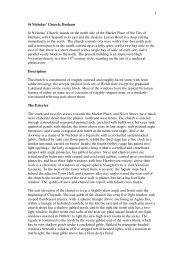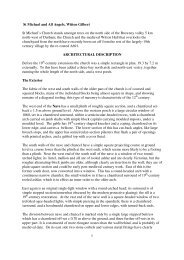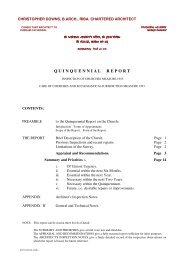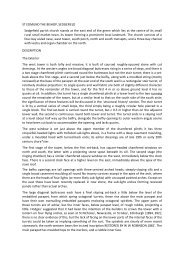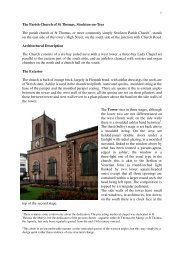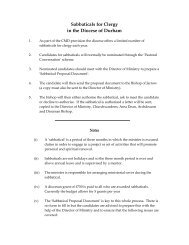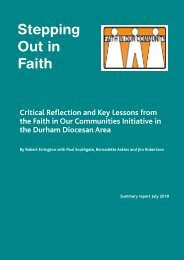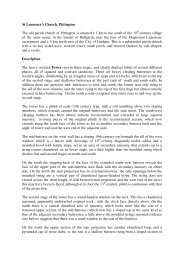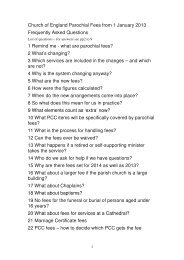1 St Peter's Church, Elwick Hall St Peter's, the parish church of ...
1 St Peter's Church, Elwick Hall St Peter's, the parish church of ...
1 St Peter's Church, Elwick Hall St Peter's, the parish church of ...
You also want an ePaper? Increase the reach of your titles
YUMPU automatically turns print PDFs into web optimized ePapers that Google loves.
<strong>church</strong>yard to a smaller gate at <strong>the</strong> head <strong>of</strong> a steep path rising<br />
up from <strong>the</strong> bridge over <strong>the</strong> beck; on <strong>the</strong> north <strong>the</strong> boundary wall<br />
is very ruinous, and runs some distance below <strong>the</strong> crest <strong>of</strong> <strong>the</strong><br />
slope.<br />
There are few monuments <strong>of</strong> especial interest; <strong>the</strong> regular rows<br />
<strong>of</strong> headstones are mostly <strong>of</strong> 19th century date, with a few 18thcentury<br />
survivals, mostly badly wea<strong>the</strong>red. A railed enclosure in<br />
<strong>the</strong> angle <strong>of</strong> chancel and south aisle contains <strong>the</strong> tomb <strong>of</strong> <strong>the</strong><br />
Park family.<br />
There is no surface indication <strong>of</strong> 'something like <strong>the</strong> stone<br />
foundations <strong>of</strong> an earlier building' discovered c 1891 (Reynolds,<br />
179) 'about six feet to <strong>the</strong> north <strong>of</strong> <strong>the</strong> present <strong>church</strong>', except<br />
perhaps for a slight platform just outside <strong>the</strong> north wall <strong>of</strong> <strong>the</strong><br />
north aisle.<br />
ARCHAEOLOGICAL ASSESSMENT<br />
The <strong>church</strong>, with its probable Pre-Conquest origins, is obviously<br />
<strong>of</strong> considerable archaeological interest, although as <strong>of</strong>ten it is<br />
difficult to predict <strong>the</strong> survival <strong>of</strong> sub-surface features. If<br />
<strong>the</strong> foundations referred to by Reynolds were <strong>of</strong> an earlier<br />
<strong>church</strong>, <strong>the</strong>n one would have to postulate a slightly unusual<br />
slight shift <strong>of</strong> site. Perhaps <strong>the</strong> foundations were <strong>the</strong> remains<br />
<strong>of</strong> <strong>the</strong> 14th-century chantry, perhaps set on <strong>the</strong> north side <strong>of</strong><br />
<strong>the</strong> chancel (where <strong>the</strong>re are hints <strong>of</strong> a return wall)<br />
The floors <strong>of</strong> <strong>the</strong> <strong>church</strong> are <strong>of</strong> no great age; most <strong>of</strong> <strong>the</strong> nave<br />
is boarded, and <strong>the</strong> sanctuary stone flagged; one blue limestone<br />
slab set centrally in front <strong>of</strong> <strong>the</strong> altar may mark <strong>the</strong> entrance<br />
to a vault. The present central heating system is above <strong>the</strong><br />
floor; although <strong>the</strong>re may well have been an earlier sub-floor<br />
system, it is probable that archaeological deposits and<br />
structures survive. Any disturbance <strong>of</strong> floor levels ought to be<br />
accompanied by an archaeological watching brief.<br />
Whilst, given <strong>the</strong> history <strong>of</strong> renovations and remodelling, it<br />
might seem unlikely that medieval plaster and paintings survive,<br />
again this cannot be ruled out, and any large-scale disturbance<br />
<strong>of</strong> plaster should be monitored.<br />
Externally, <strong>the</strong>re has been a perimeter drain adjoining <strong>the</strong><br />
external faces <strong>of</strong> <strong>the</strong> <strong>church</strong> walls since <strong>the</strong> early 19th century;<br />
however this is relatively shallow in parts, and cannot be<br />
assumed to have destroyed all archaeological material. The area<br />
to <strong>the</strong> north <strong>of</strong> <strong>the</strong> chancel is <strong>of</strong> especial interest in view <strong>of</strong><br />
<strong>the</strong> evidence <strong>of</strong> a medieval structure <strong>the</strong>re. Any groundworks in<br />
<strong>the</strong> <strong>church</strong>yard, and in particular an close to <strong>the</strong> <strong>church</strong> itself,<br />
will require a watching brief.<br />
Peter F Ryder<br />
May 1995<br />
12




